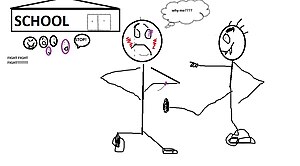| English: this is my own version of what bullying looks like (Photo credit: Wikipedia) |
As I have mentioned here, at the excellent conference at Seattle University, I was lucky enough to present a half-day session on Bullying and IDEA. It is rare to get to discuss these important topics in such depth, and I thank the Institute as well as the participants who were incredibly helpful during the presentation.
In a previous post, I mentioned our detailed discussion of the definition of bullying. In this post, I'm going to summarize our discussion of the public policy question. (Yes, I guess that there is a reason why I got that masters degree in public policy after all.)
Some participants questioned whether the school districts should have a role in bullying, ie is there a government interest? Most participants felt that bullying, which as we know from the definition requires a power imbalance, requires intervention. A number of participants, however, felt that dealing with bullies is one of the life lessons that one has to learn. They pointed out their own school bullies, as well as judge bullies and others in later life. We also discussed our popular culture images regarding this issue. Pick almost any movie with bullies and the victim eventually gets ticked off and does in the bad guy. The best example is "A Christmas Story," the popular Christmas movie in which Farkus bullies Ralphie until one day he gets possessed and beats the heck out of him while imitating his father's bad language. Most other movies involving bullies have a similar plot line.
But most participants felt that bullying is different because of the power imbalance. What do you think? What exactly is the role of government, here the school district, with respect to bullying?













I think this discussion hit the nail on the head-- bullying is related to power. My 9th grade students are currently working on projects to come up with possible solutions for the bullying problems at our school. I think part of the role of schools is to empower all students-- especially students with disabilities-- and use these situations as teachable moments to try and empower with education!
ReplyDeleteI believe that bullying has been evolving with time. In the past kids would tease someone because of a funny looking hair cut and would carry on for sometime because it got old. But now children are using technology to bully others by using pictures and videos and worst of all the bully can be unanimous so the tease can continue for a long period of time. As child advocates we must find a way to keep kids safe from ridicule and humiliation so that they can stand up for themselves and be productive citizens.
ReplyDeleteThanks Anon & Anon
ReplyDeleteJG